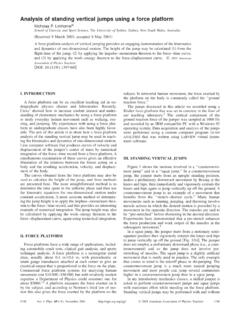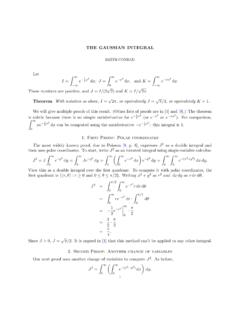Transcription of 4. Analysis of Standing Vertical Jumps Using a Force Platform
1 1 4. Analysis of Standing Vertical Jumps Using a Force Platform OBJECTIVES To examine a Standing Vertical jump from the viewpoints of Force -time, velocity-time, position-time, and Force -position. To develop a greater understanding of the relations between Force , acceleration, velocity, and displacement. To calculate the flight height of a jump from the time of flight and by Using the impulse-momentum relation. INTRODUCTION In this session you will use the output of a Force Platform to analyse a Standing Vertical jump . A physically active male participant performed two maximum-effort Jumps while Standing on a Force Platform . The Jumps were a countermovement jump (CMJ) and a jump with no countermovement ( a squat jump , SJ) starting from about the same height as the low-point of the countermovement jump .
2 The participant performed both Jumps with the hands placed firmly on the hips. afghadfgh(a)(b) (Linthorne, 2001) CMJ SJ Vertical jump Lab 2 PROCEDURE Go to one of the University computers and log on to the computer in the usual way. Open a web browser (Netscape or Internet Explorer) and go to the Laboratory Items page on the Biomechanics of Sport and Exercise Blackboard site. Vertical is a stand-alone application for analysing Vertical jumping, and it has two associated data files, Countermovement and Squat Copy these 3 files from the Blackboard site to your computer hard disk.
3 (I suggest you place the files in the My Documents folder.) Start the application program by double-clicking on the Vertical icon. After a few seconds the Vertical jump window will appear, but without any traces in the graph windows. 1. COUNTERMOVEMENT jump From the Operate menu, select Run. The Choose File to Read window will appear. Select the countermovement jump data file (Countermovement ) and click Open. The traces for a countermovement jump will appear. Vertical jump Lab 3 Force -Time Curve The main graph shows Vertical ground reaction Force (in newtons) on the Vertical axis, and time (in seconds) on the horizontal axis. Identify the following regions on the Force -time curve: initial stationary position (FGRF = BW) unweighting phase (FGRF < BW) propulsion phase (FGRF > BW) instant of take-off (FGRF = 0 N) flight phase (FGRF = 0 N) instant of landing the landing impact Force peak final stationary position (FGRF = BW).
4 You might wish to enlarge the graph by changing the ranges of the time and Force axes. Suggested ranges are to seconds, and 0 to 2000 N. Select the end value of the time axis (should be ) by clicking with the mouse. Type in the new end value ( ), then press the Enter key. Repeat for the Force axis. There are two coloured Vertical lines (cursors) on the Force -time graph. Click on one of the cursors with the mouse. Hold down the left-hand mouse button and drag the cursor to the left and right. The time (in seconds) and Force (in newtons) corresponding to the positions of the cursor are displayed in the Cursor 1 and Cursor 2 boxes below the graph. Trouble-Shooting (if you have problems) When rescaling the time axis, make sure that the cursors are within the selected time interval, otherwise you will lose the cursors.
5 If you find that you have lost a cursor, rescale the time axis to the original settings ( to seconds). Minor software bug #1: Changing the time axis scale will reset the Force axis scale to the original setting (0 to 4000 N). Minor software bug #2: When the cursors are moved to the far left or right of the graph, the curve might scroll out of view. Reset the curve into view by typing the appropriate start and finish times (or forces) into the graph axes. (Don t forget to press the Enter key after inserting the values.) Fixing Difficult Software Problems: If all else fails, click on the Press when Finished button, then select Exit from the File menu. Start the application program as before. Vertical Velocity and Vertical Position Curves There are three graphs to the right of the main Force -time graph.
6 These are graphs of: Vertical velocity (in m/s) versus time (in milliseconds) Vertical position (in cm) versus time (in milliseconds) Vertical ground reaction Force (in newtons) versus Vertical position (in cm). Consider only the first two graphs (velocity-time and position-time). These curves are obtained from calculations Using the Force -time data between the green (start) and red (finish) cursors. Place the green cursor in a region of constant Force (FGRF = BW) just before the start of the jump . Place the red cursor slightly to the right of the green cursor. Slowly move the red cursor along the time axis and watch the curves of velocity-time and position-time. Stop when you reach the instant of landing.
7 Vertical jump Lab 4 Move the red cursor about, and accurately identify the following points: Vertical velocity is greatest downwards (negative) during the countermovement Vertical velocity is greatest upwards (positive) lowest point in the countermovement ( Vertical position is a minimum, and Vertical velocity is zero) peak of the jump ( Vertical position is a maximum, and Vertical velocity is zero). Mark these points on the graph of the Force -time curve below. What is the jumper s Vertical height at the instant of take-off? Is this what you expect? Where on the Force -time curve is the lowest point in the countermovement? Is this what you expect? Why is the maximum Vertical velocity just before take-off (and not at the instant of take-off)?
8 Force vs Vertical Position Curve Place the green cursor in a region of constant Force (FGRF = BW) just before the start of the jump . Place the red cursor slightly to the right of the green cursor. Slowly move the red cursor along the time axis and watch the graph of Force -position. This graph might take a while for you to interpret. Make sure you understand this graph. Finish When you have finished analysing the countermovement jump , click on the red Press when Finished button at the lower right of the Vertical jump window. Vertical jump Lab 5 2. SQUAT jump From the Operate menu, select Run. The Chose File to Read window will appear. Select the squat jump data file (Squat ) and click Open.
9 The traces for a squat jump will appear. Go through the same Analysis for the squat jump as was done for the countermovement jump . Finish When you have finished analysing the squat jump , click on the red Press when Finished button at the lower right of the Vertical jump window. Vertical jump Lab 6 3. jump HEIGHT Here, you will investigate two methods of calculating the height of the jump from the Force Platform data; (1) the flight time method, and (2) the impulse-momentum method. Both methods calculate the flight height from knowledge of the velocity of the jumper s at the instant of takeoff. The relation between flight height yflight and takeoff velocity vtake-off can be obtained by applying the law of conservation of mechanical energy to the flight phase of the jump .
10 The mechanical energy (E) of the jumper is the sum of the kinetic energy (KE = mv2) and gravitational potential energy (PE = mgy). In Vertical jumping the effect of air resistance is negligible, and so in the flight phase the jumper can be considered as a projectile in free flight. The mechanical energy of the jumper at one instant is therefore the same as the mechanical energy at any other instant. We consider the changes in mechanical energy between the instant of takeoff (take-off) and the instant the jumper reaches the peak of the jump (peak). Etake-off = Epeak KEtake-off + PEtake-off = KEpeak + PEpeak mvtake-off2 + mgytake-off = mvpeak2 + mgypeak . The mass of the jumper can be cancelled from both sides of the equation, leaving vtake-off2 + gytake-off = vpeak2 + gypeak.












